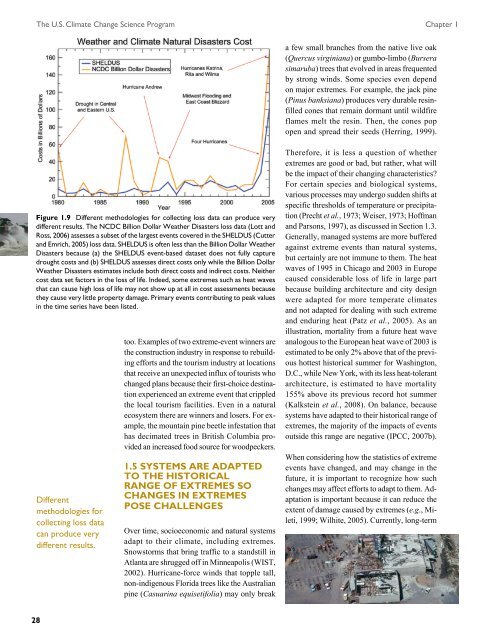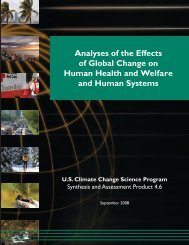Weather and Climate Extremes in a Changing Climate. Regions of ...
Weather and Climate Extremes in a Changing Climate. Regions of ...
Weather and Climate Extremes in a Changing Climate. Regions of ...
You also want an ePaper? Increase the reach of your titles
YUMPU automatically turns print PDFs into web optimized ePapers that Google loves.
The U.S. <strong>Climate</strong> Change Science Program Chapter 1<br />
Figure 1.9 Different methodologies for collect<strong>in</strong>g loss data can produce very<br />
different results. The NCDC Billion Dollar <strong>Weather</strong> Disasters loss data (Lott <strong>and</strong><br />
Ross, 2006) assesses a subset <strong>of</strong> the largest events covered <strong>in</strong> the SHELDUS (Cutter<br />
<strong>and</strong> Emrich, 2005) loss data. SHELDUS is <strong>of</strong>ten less than the Billion Dollar <strong>Weather</strong><br />
Disasters because (a) the SHELDUS event-based dataset does not fully capture<br />
drought costs <strong>and</strong> (b) SHELDUS assesses direct costs only while the Billion Dollar<br />
<strong>Weather</strong> Disasters estimates <strong>in</strong>clude both direct costs <strong>and</strong> <strong>in</strong>direct costs. Neither<br />
cost data set factors <strong>in</strong> the loss <strong>of</strong> life. Indeed, some extremes such as heat waves<br />
that can cause high loss <strong>of</strong> life may not show up at all <strong>in</strong> cost assessments because<br />
they cause very little property damage. Primary events contribut<strong>in</strong>g to peak values<br />
<strong>in</strong> the time series have been listed.<br />
Different<br />
methodologies for<br />
collect<strong>in</strong>g loss data<br />
can produce very<br />
different results.<br />
28<br />
too. Examples <strong>of</strong> two extreme-event w<strong>in</strong>ners are<br />
the construction <strong>in</strong>dustry <strong>in</strong> response to rebuild<strong>in</strong>g<br />
efforts <strong>and</strong> the tourism <strong>in</strong>dustry at locations<br />
that receive an unexpected <strong>in</strong>flux <strong>of</strong> tourists who<br />
changed plans because their first-choice dest<strong>in</strong>ation<br />
experienced an extreme event that crippled<br />
the local tourism facilities. Even <strong>in</strong> a natural<br />
ecosystem there are w<strong>in</strong>ners <strong>and</strong> losers. For example,<br />
the mounta<strong>in</strong> p<strong>in</strong>e beetle <strong>in</strong>festation that<br />
has decimated trees <strong>in</strong> British Columbia provided<br />
an <strong>in</strong>creased food source for woodpeckers.<br />
1.5 SyStEMS ARE AdAPtEd<br />
TO ThE hISTORICAl<br />
RANGE OF EXtREMES SO<br />
ChANgES IN ExTREMES<br />
POSE CHALLENGES<br />
Over time, socioeconomic <strong>and</strong> natural systems<br />
adapt to their climate, <strong>in</strong>clud<strong>in</strong>g extremes.<br />
Snowstorms that br<strong>in</strong>g traffic to a st<strong>and</strong>still <strong>in</strong><br />
Atlanta are shrugged <strong>of</strong>f <strong>in</strong> M<strong>in</strong>neapolis (WIST,<br />
2002). Hurricane-force w<strong>in</strong>ds that topple tall,<br />
non-<strong>in</strong>digenous Florida trees like the Australian<br />
p<strong>in</strong>e (Casuar<strong>in</strong>a equisetifolia) may only break<br />
a few small branches from the native live oak<br />
(Quercus virg<strong>in</strong>iana) or gumbo-limbo (Bursera<br />
simaruba) trees that evolved <strong>in</strong> areas frequented<br />
by strong w<strong>in</strong>ds. Some species even depend<br />
on major extremes. For example, the jack p<strong>in</strong>e<br />
(P<strong>in</strong>us banksiana) produces very durable res<strong>in</strong>filled<br />
cones that rema<strong>in</strong> dormant until wildfire<br />
flames melt the res<strong>in</strong>. Then, the cones pop<br />
open <strong>and</strong> spread their seeds (Herr<strong>in</strong>g, 1999).<br />
Therefore, it is less a question <strong>of</strong> whether<br />
extremes are good or bad, but rather, what will<br />
be the impact <strong>of</strong> their chang<strong>in</strong>g characteristics?<br />
For certa<strong>in</strong> species <strong>and</strong> biological systems,<br />
various processes may undergo sudden shifts at<br />
specific thresholds <strong>of</strong> temperature or precipitation<br />
(Precht et al., 1973; Weiser, 1973; H<strong>of</strong>fman<br />
<strong>and</strong> Parsons, 1997), as discussed <strong>in</strong> Section 1.3.<br />
Generally, managed systems are more buffered<br />
aga<strong>in</strong>st extreme events than natural systems,<br />
but certa<strong>in</strong>ly are not immune to them. The heat<br />
waves <strong>of</strong> 1995 <strong>in</strong> Chicago <strong>and</strong> 2003 <strong>in</strong> Europe<br />
caused considerable loss <strong>of</strong> life <strong>in</strong> large part<br />
because build<strong>in</strong>g architecture <strong>and</strong> city design<br />
were adapted for more temperate climates<br />
<strong>and</strong> not adapted for deal<strong>in</strong>g with such extreme<br />
<strong>and</strong> endur<strong>in</strong>g heat (Patz et al., 2005). As an<br />
illustration, mortality from a future heat wave<br />
analogous to the European heat wave <strong>of</strong> 2003 is<br />
estimated to be only 2% above that <strong>of</strong> the previous<br />
hottest historical summer for Wash<strong>in</strong>gton,<br />
D.C., while New York, with its less heat-tolerant<br />
architecture, is estimated to have mortality<br />
155% above its previous record hot summer<br />
(Kalkste<strong>in</strong> et al., 2008). On balance, because<br />
systems have adapted to their historical range <strong>of</strong><br />
extremes, the majority <strong>of</strong> the impacts <strong>of</strong> events<br />
outside this range are negative (IPCC, 2007b).<br />
When consider<strong>in</strong>g how the statistics <strong>of</strong> extreme<br />
events have changed, <strong>and</strong> may change <strong>in</strong> the<br />
future, it is important to recognize how such<br />
changes may affect efforts to adapt to them. Adaptation<br />
is important because it can reduce the<br />
extent <strong>of</strong> damage caused by extremes (e.g., Mileti,<br />
1999; Wilhite, 2005). Currently, long-term




